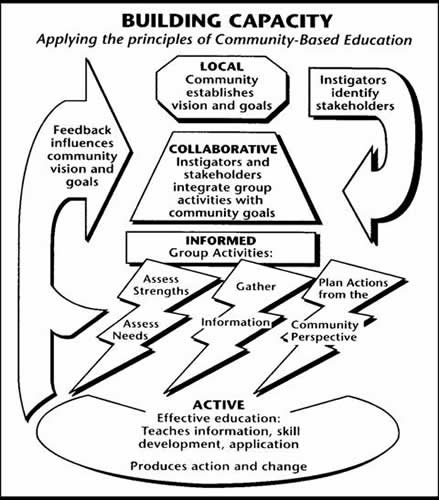Steps for Choosing Effective Outreach Techniques
1. Describe the environmental concern or opportunity.
2. Identify preliminary target audience(s).
3. Determine specific actions citizens need to take to accomplish your management goal.
4. Collect audience information relevant to the environmental practices and specific behaviors.
5. Assess potential for adoption of single behaviors and the environmental practice.
6. Select single behaviors for intervention focus.
7. Select intervention technique(s).
Step 7. Select intervention technique(s)
Developing a strategy: short term or long term change?
A Model of Community Based Environmental Education
Advice for how to think about a long-term perspective for any natural resources outreach strategy is derived from a 1998 study (Andrews) funded by the United States Environmental Protection Agency (US EPA) and the United States Department of Agriculture (USDA).
This project focused on two issues: how to support community involvement in decision-making about the environment, and how to most efficiently and effectively use the strengths of the sponsoring agencies, US EPA and USDA Cooperative Extension, when working with communities. Project findings are presented in terms of EPA and Cooperative Extension roles and partnership possibilities. See Supporting Community-Based Environmental Education: Discussion Paper Summary, and the original study cited below, for more information about the research process supporting these findings.
Key Findings from the Study
Local Base is Fundamental: Address a locally identified issue and work toward a positive outcome.
Collaboration is Powerful and Practical: Work with a coalition or group, giving attention to techniques that support group effectiveness.
Informed Action is Empowering and Productive: Take action based on information, within the context of community goals.
Effective Education is Active: Engage the broader group by using tested education practices. Community-based education implies an education plan created as a result of community involvement and designed to match community interests. Effective CBEE takes advantage of educational theory and research and uses tested techniques for promoting action and behavior change.
Elements of Effective Education Strategy
- Presents all points of view.
- Relates to a specific audience, its needs, and learning styles.
- Presents behavior choices that are relatively low cost in time, energy, money, and materials.
- Gives the audience opportunities for self-assessment and applying new skills.
- Uses creative approaches.
Resources
Andrews, E., 1998. An EPA/USDA Partnership to Support Community-based Education – A Discussion Paper. EPA 910-R-98-008




